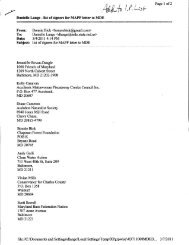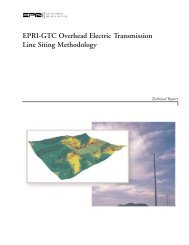Mid-Atlantic Power Pathway Chalk Point Substation to Indian River ...
Mid-Atlantic Power Pathway Chalk Point Substation to Indian River ...
Mid-Atlantic Power Pathway Chalk Point Substation to Indian River ...
You also want an ePaper? Increase the reach of your titles
YUMPU automatically turns print PDFs into web optimized ePapers that Google loves.
<strong>Mid</strong>-<strong>Atlantic</strong> <strong>Power</strong> <strong>Pathway</strong> Environmental Review Document<br />
<strong>Chalk</strong> <strong>Point</strong> <strong>Substation</strong> <strong>to</strong> <strong>Indian</strong> <strong>River</strong> <strong>Substation</strong> Volume II – Environmental Analysis of<br />
April 13, 2011 <strong>Chalk</strong> <strong>Point</strong> <strong>Substation</strong> <strong>to</strong> MD/DE State Line<br />
Table 1.2-1 (continued)<br />
Soil Series Within the Project Right-of-Way and Project Boundaries<br />
Soil Series Description<br />
Beltsville The Beltsville series consists of deep moderately well-drained soils on uplands. They<br />
formed in Coastal Plain sediments. Typically, these soils have grayish-brown and light<br />
olive brown silt loam surface layers <strong>to</strong> a depth of 9 inches. The subsoil from 9 <strong>to</strong> 25<br />
inches is yellowish-brown silt loam and silty clay loam. From 25 <strong>to</strong> 50 inches is a very<br />
firm and brittle silty clay loam fragipan. The substratum from 50 <strong>to</strong> 72 inches is very<br />
pale brown gravelly sandy loam. The parent material consists of silty eolian deposits<br />
over loamy fluviomarine deposits. Depth <strong>to</strong> a root restrictive layer, fragipan, is 20 <strong>to</strong> 40<br />
inches. The natural drainage class is moderately well drained. Water movement in the<br />
most restrictive layer is moderately low. Available water <strong>to</strong> a depth of 60 inches is low.<br />
Shrink-swell potential is low. This soil is not flooded. It is not ponded. A seasonal zone<br />
of water saturation is at 24 inches during January, February, March, April, and<br />
December. Organic matter content in the surface horizon is about 3 percent. This soil<br />
does not meet hydric criteria.<br />
Berryland The Berryland series consists of deep very poorly drained soils on uplands. They formed<br />
in Coastal Plain sediments. Typically these soils have a black sand surface layer 10<br />
inches thick over 2 inches of gray sand. The subsoil from 12 <strong>to</strong> 20 inches is firm and<br />
weakly cemented dark reddish brown loamy sand. From 20 <strong>to</strong> 30 inches the subsoil is<br />
dark gray loose sand. The substratum from 30 <strong>to</strong> 72 inches is grayish brown stratified<br />
loose sand. This soil is very poorly drained. The slowest permeability within 60 inches<br />
is moderately rapid <strong>to</strong> rapid. Available water capacity is very high and shrink swell<br />
potential is low. This soil is rarely flooded and is not ponded. The <strong>to</strong>p of the seasonal<br />
high water table is at 0 inches. There are no saline horizons. This component is a hydric<br />
soil. Berryland, drained – The soil is not flooded and is rarely ponded. The <strong>to</strong>p of the<br />
seasonal high water table is at 5 inches. Berryland, undrained – The soil is not flooded<br />
and is frequently ponded. The <strong>to</strong>p of the seasonal high water table is at 2 inches.<br />
Butler<strong>to</strong>wn The Butler<strong>to</strong>wn series consists of deep well drained <strong>to</strong> moderately well drained soils on<br />
uplands. They formed in Coastal Plain sediments. Typically these soils have a dark<br />
grayish brown silt loam surface layer 10 inches thick. The subsoil from 10 <strong>to</strong> 34 inches<br />
is light yellowish brown and yellowish brown silt loam. A firm and brittle fragipan from<br />
34 <strong>to</strong> 49 inches is mottled yellowish brown silt loam. The substratum from 49 <strong>to</strong> 60<br />
inches is mottled yellowish brown silt loam. Depth <strong>to</strong> a root restrictive layer is greater<br />
than 60 inches. Water movement in the most restrictive layer is moderately low.<br />
Available water <strong>to</strong> a depth of 60 inches is high. Shrink-swell potential is low. This soil is<br />
not flooded. It is not ponded. A seasonal zone of water saturation is at 36 inches during<br />
February and March. Organic matter content in the surface horizon is about 2 percent.<br />
This soil does not meet hydric criteria.<br />
Cedar<strong>to</strong>wn The Cedar<strong>to</strong>wn series consists of very deep somewhat excessively drained soils on<br />
uplands of the <strong>Mid</strong>-<strong>Atlantic</strong> Coastal Plain. They formed in sandy alluvial and marine<br />
sediments. Typically, these soils have a dark brown loamy sand surface from 0 <strong>to</strong> 6<br />
inches. The subsurface from 6 <strong>to</strong> 14 inches is light yellowish brown sand. The subsoil<br />
from 14 <strong>to</strong> 30 inches is strong brown loamy sand. The substratum from 30 <strong>to</strong> 42 inches<br />
is strong brown loamy sand, brownish yellow sand from 42 <strong>to</strong> 54 inches, mottled<br />
yellowish brown sand from 54 <strong>to</strong> 64 inches, and mottled gray fine sandy loam from 64<br />
<strong>to</strong> 72 inches. This soil is somewhat excessively drained. This soil is not flooded and is<br />
not ponded. The <strong>to</strong>p of the seasonal high water table is at 45 <strong>to</strong> 57 inches. There are no<br />
saline horizons. This component is not a hydric soil.<br />
1-16




